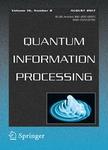版权所有:内蒙古大学图书馆 技术提供:维普资讯• 智图
内蒙古自治区呼和浩特市赛罕区大学西街235号 邮编: 010021

作者机构:Southwest Jiaotong Univ Int Cooperat Res Ctr China Commun & Sensor Network Sch Informat Sci & Technol Informat Quantum Technol Lab Chengdu 610031 Peoples R China Sichuan Zhitu Linghai Intelligent Technol Co Ltd Chengdu 610213 Peoples R China
出 版 物:《QUANTUM INFORMATION PROCESSING》 (Quantum Inf. Process.)
年 卷 期:2025年第24卷第2期
页 面:1-21页
核心收录:
学科分类:07[理学] 070201[理学-理论物理] 0702[理学-物理学]
基 金:National Key Research and Development Program of China [2021YFA0718803] National Key Research and Development Program of China National Natural Science Foundation of China (NSFC)
主 题:Quantum residual attention neural network Quantum machine learning Few-shot learning Parameterized quantum circuit Material property prediction
摘 要:The rapid advancement of quantum neural networks has led to the application of a range of quantum machine learning algorithms, such as the hybrid quantum convolutional neural network (HQCNN), in various data processing tasks. To further enhance the convergence rate and accuracy of learning from a small number of samples, we introduce a novel model called quantum residual attention neural network (QRANN), which incorporates a quantum residual attention layer (QRAL) to reduce the depth of the quantum circuit and the number of trained parameters. The benefits of this new model are demonstrated through its application to the efficient prediction of material properties based on component optimization. Specifically, we conducted numerical experiments using publicly available alloy material datasets from a hackathon competition to predict the properties of alloy materials based on their composition. The results indicate that the proposed QRANN algorithm exhibits superior performance in terms of training convergence speed, prediction accuracy, and generalization ability compared to HQCNN, QSANN, variational quantum regression (VQR) algorithm, and classical multilayer perceptron. This suggests that QRANN is particularly well-suited for learning from limited datasets. Notably, by introducing a fully parameterized QRAL, QRANN can be implemented with fewer parameters and a lower circuit depth compared to HQCNN, using approximately only 74% and 58% of the parameters and circuit depth used in HQCNN experiments, respectively. Therefore, the proposed algorithm can be feasibly realized using current noisy intermediate-scale quantum devices.